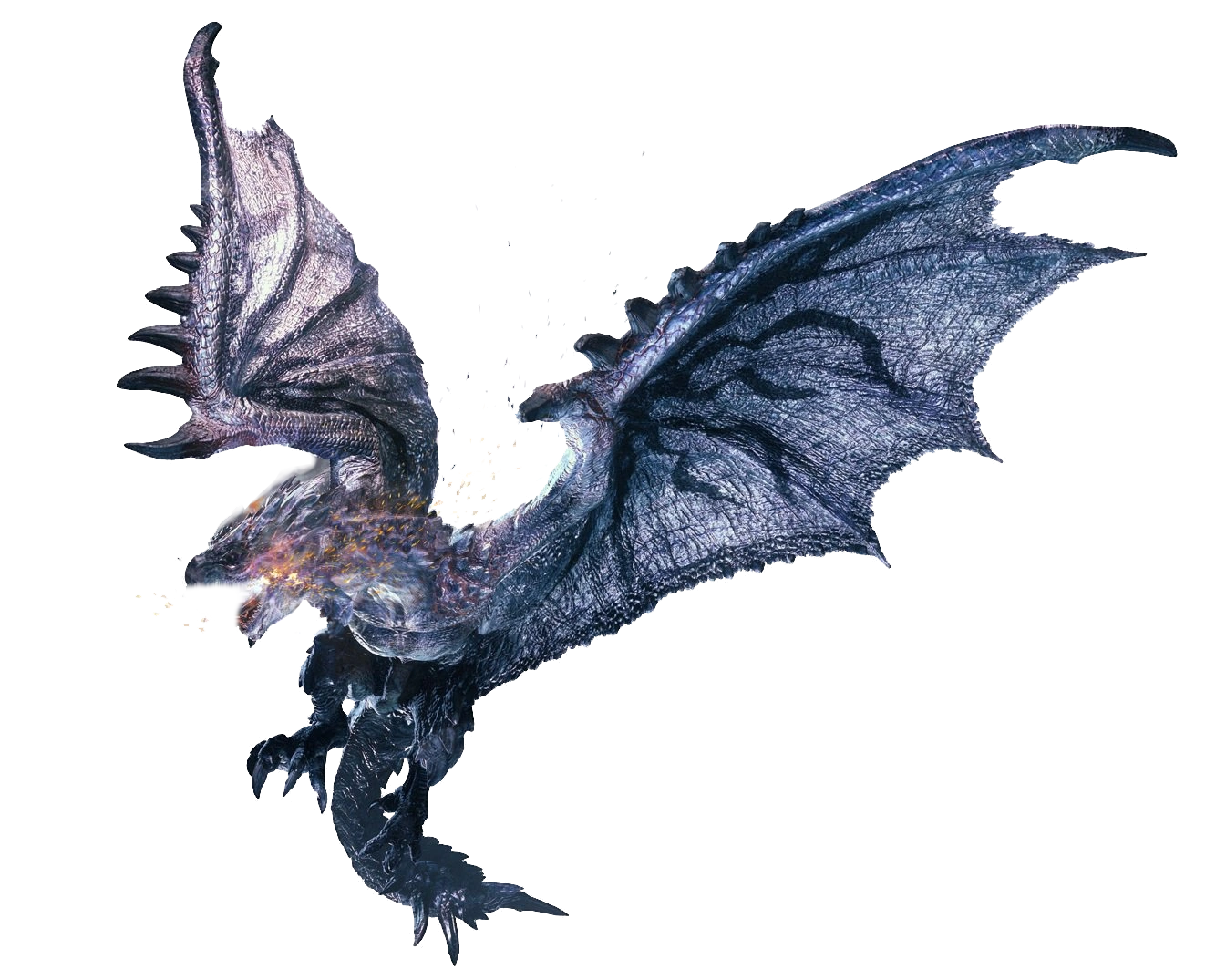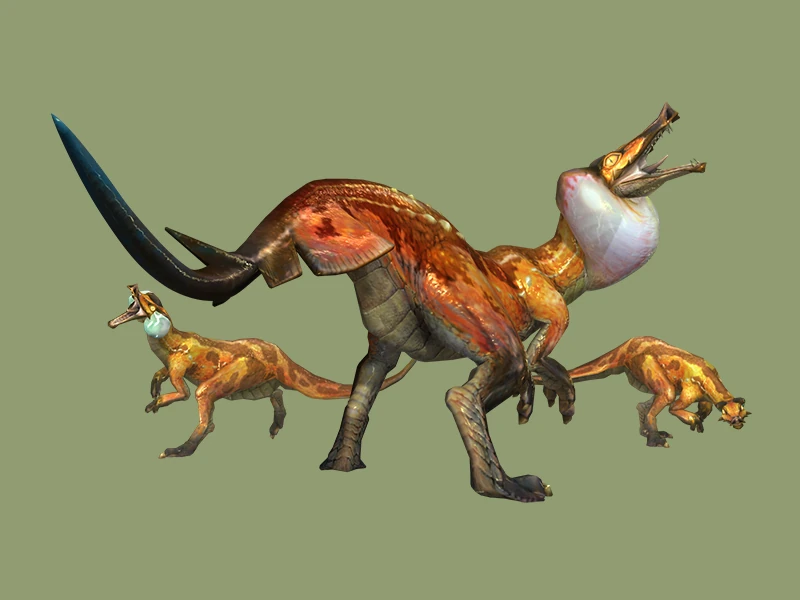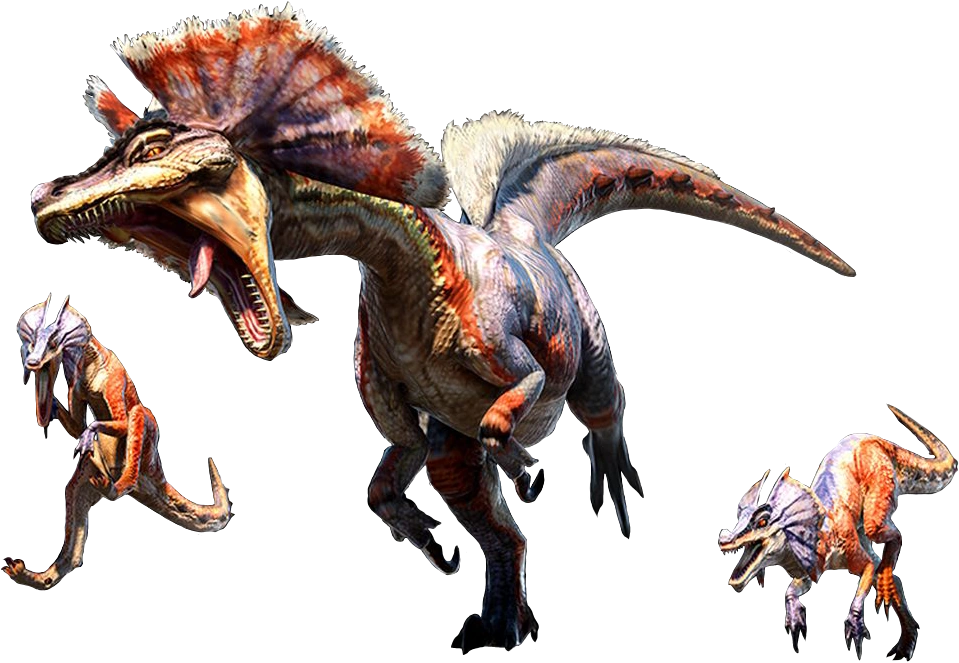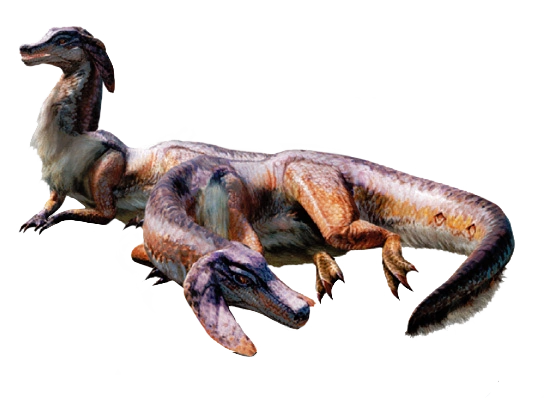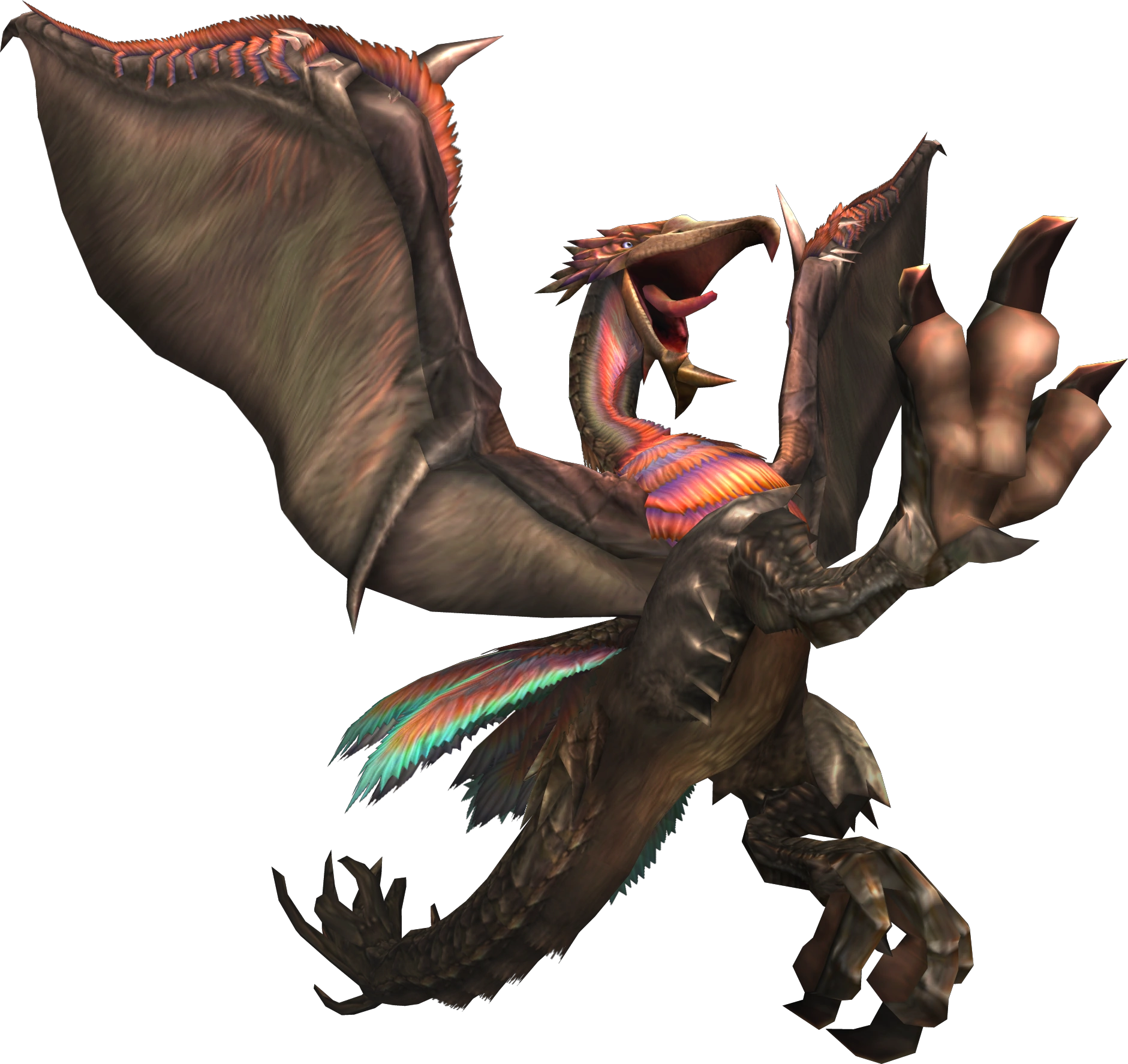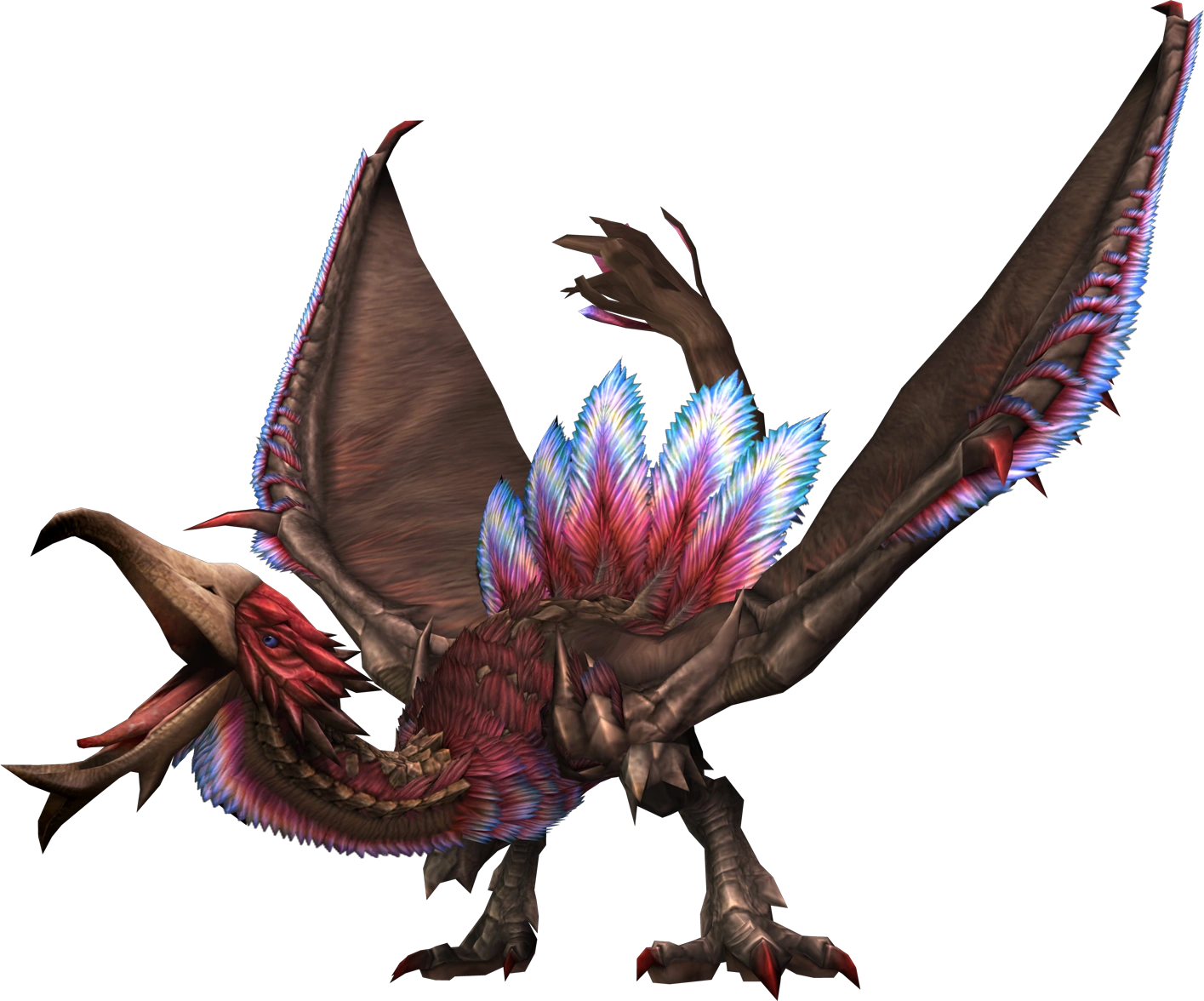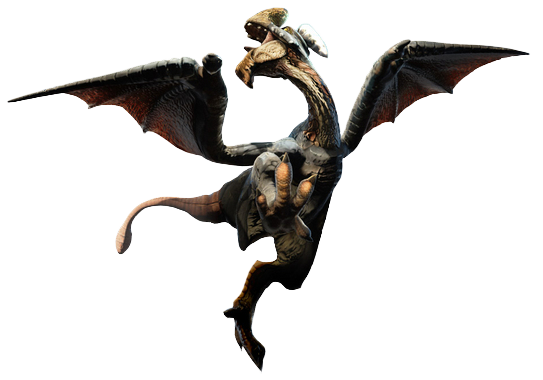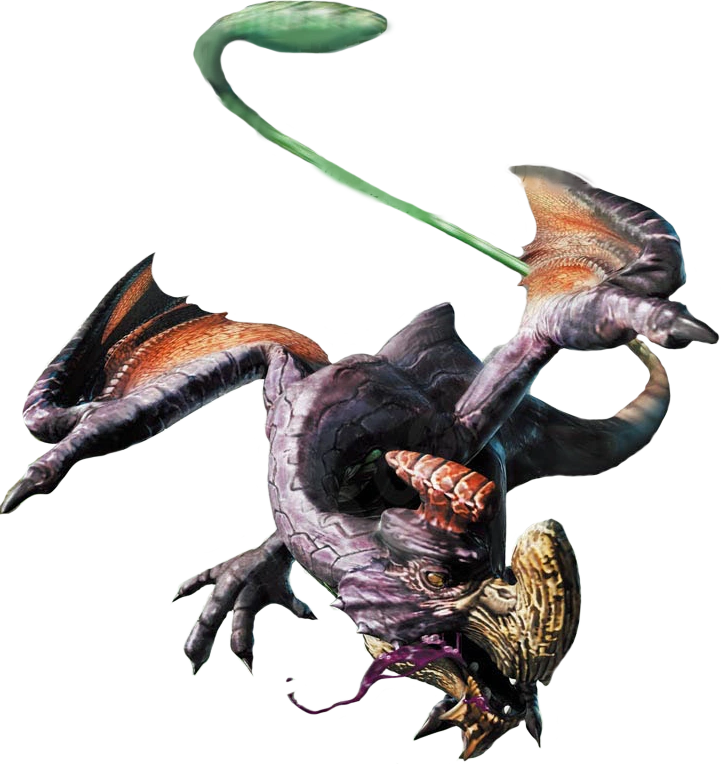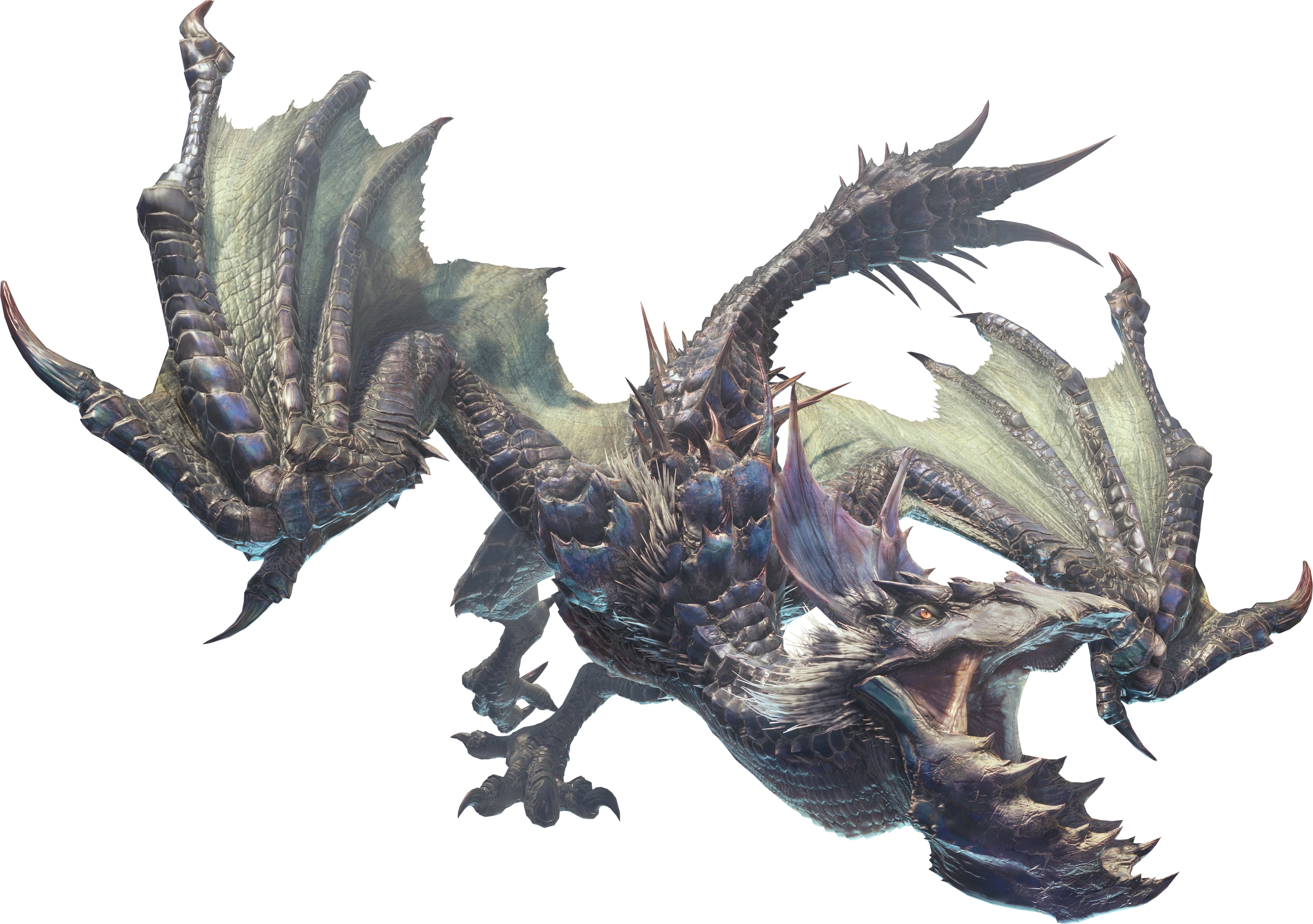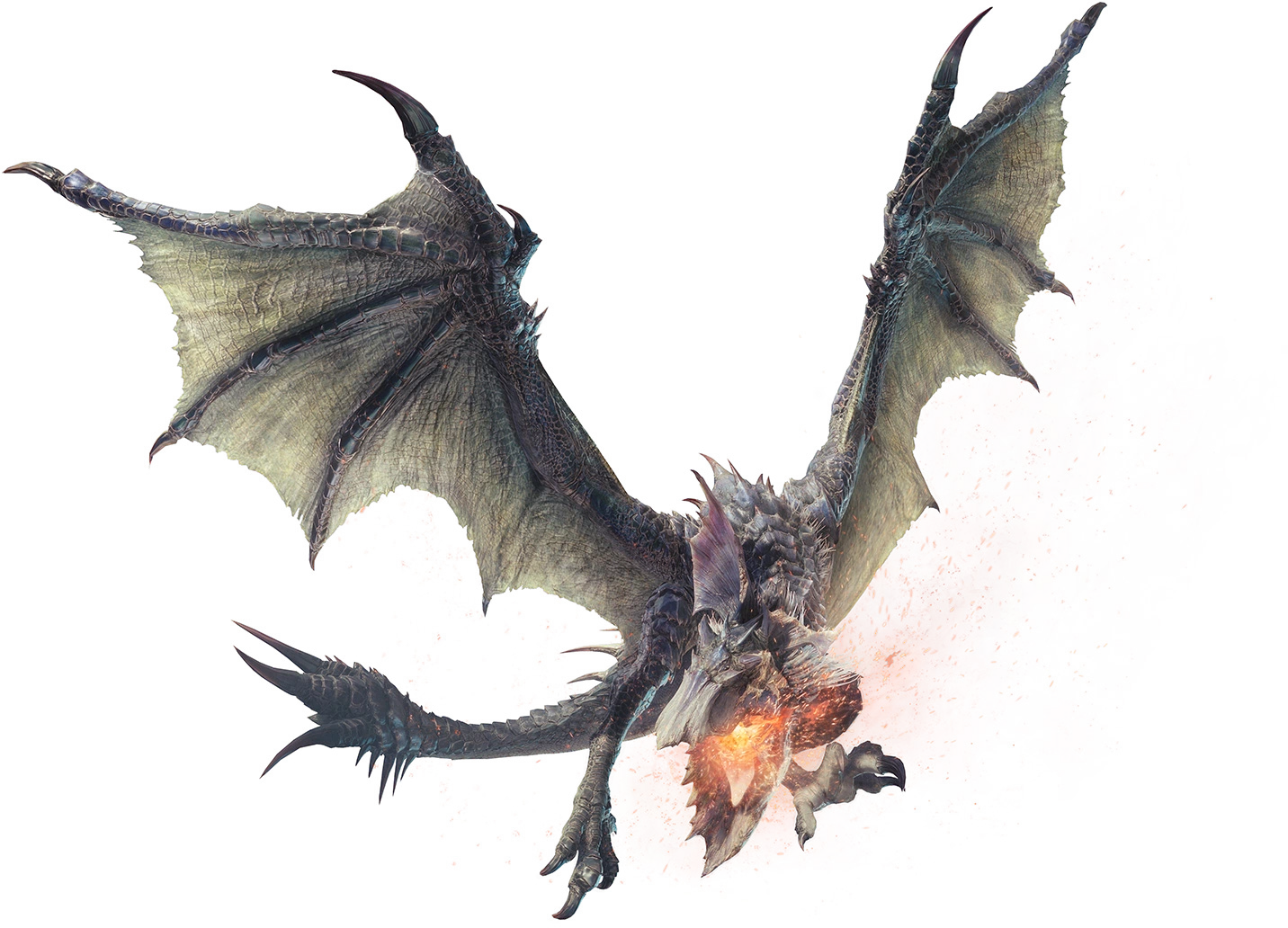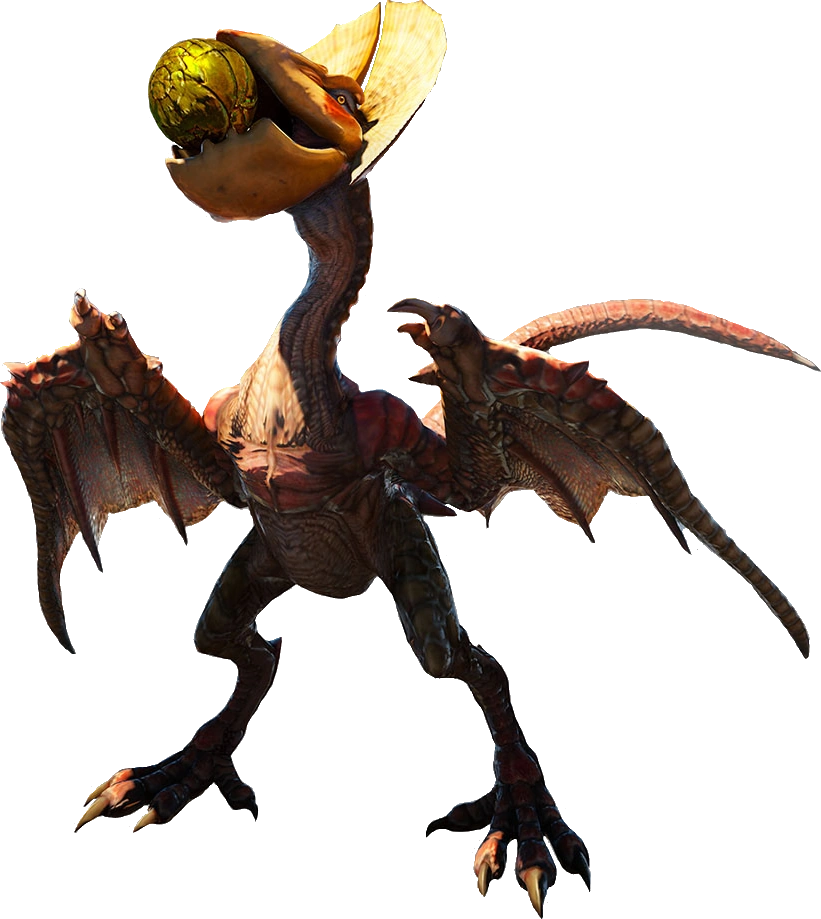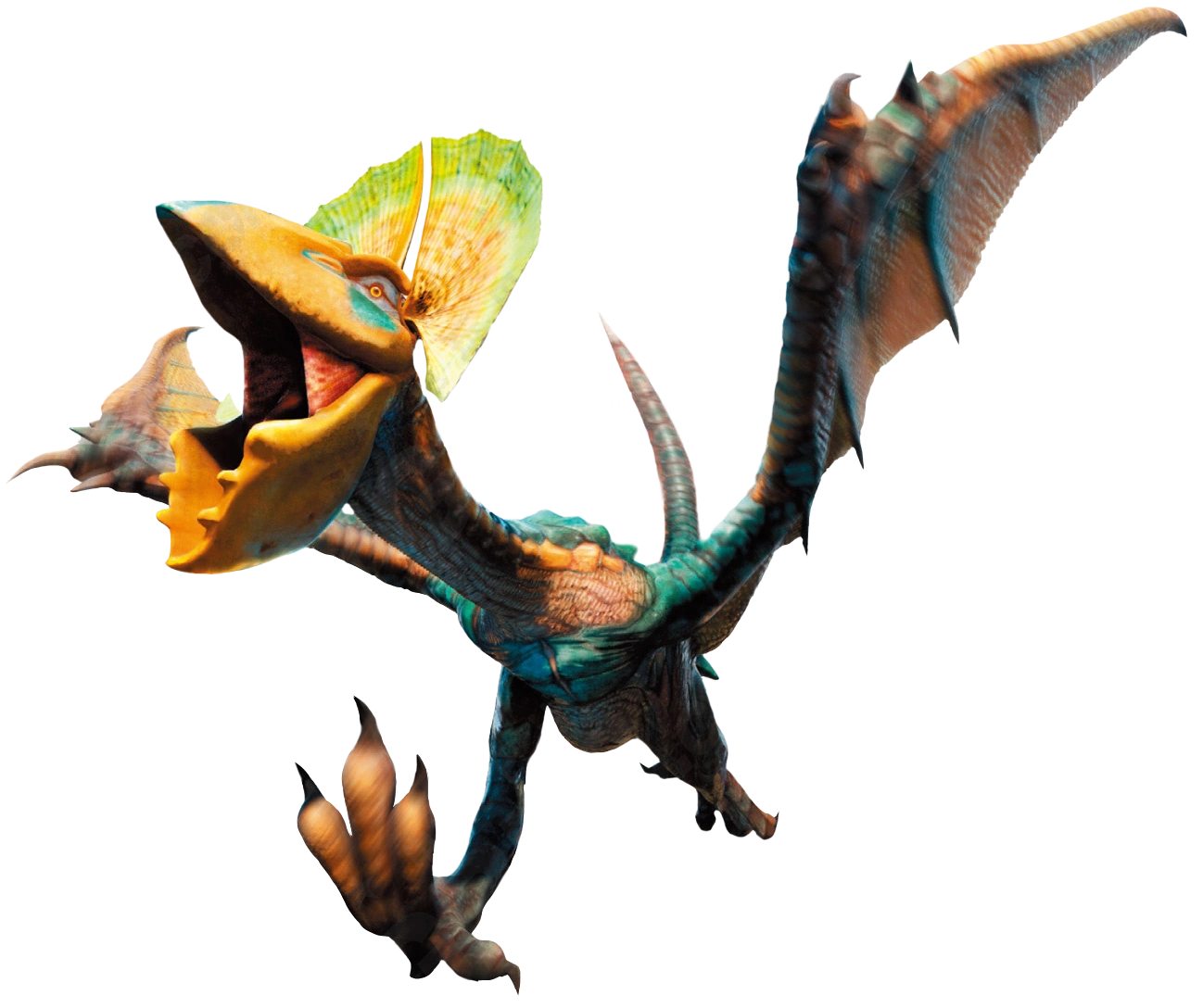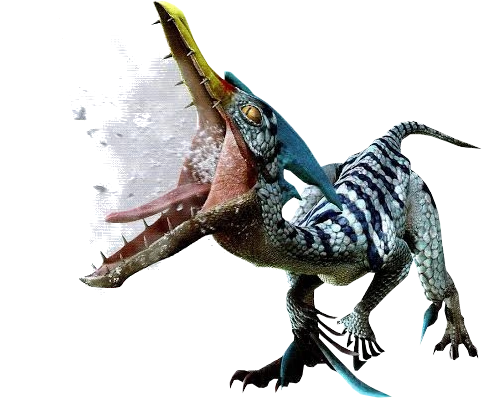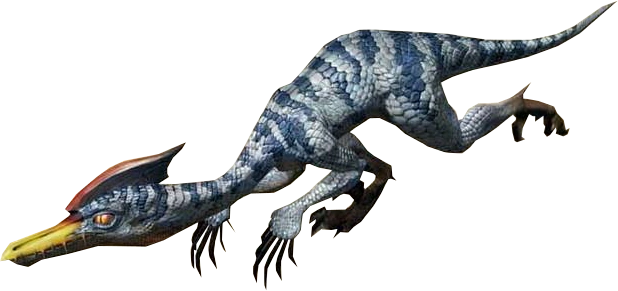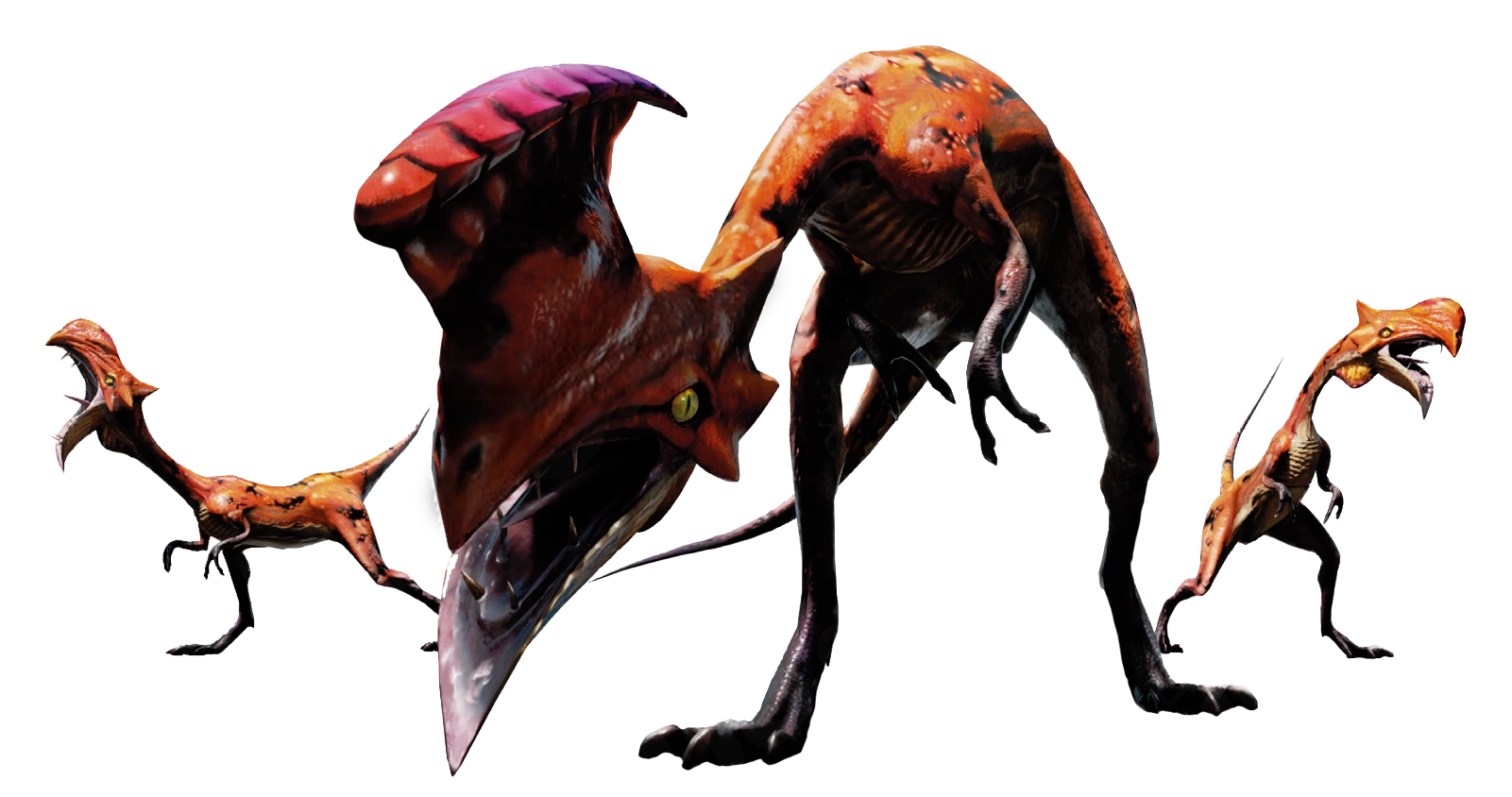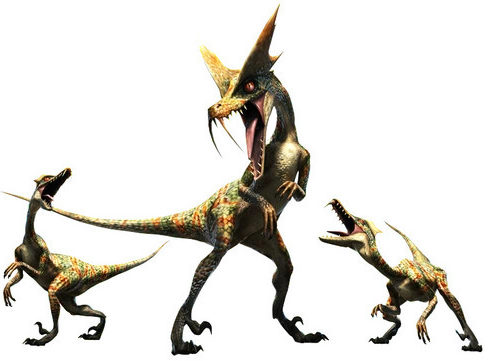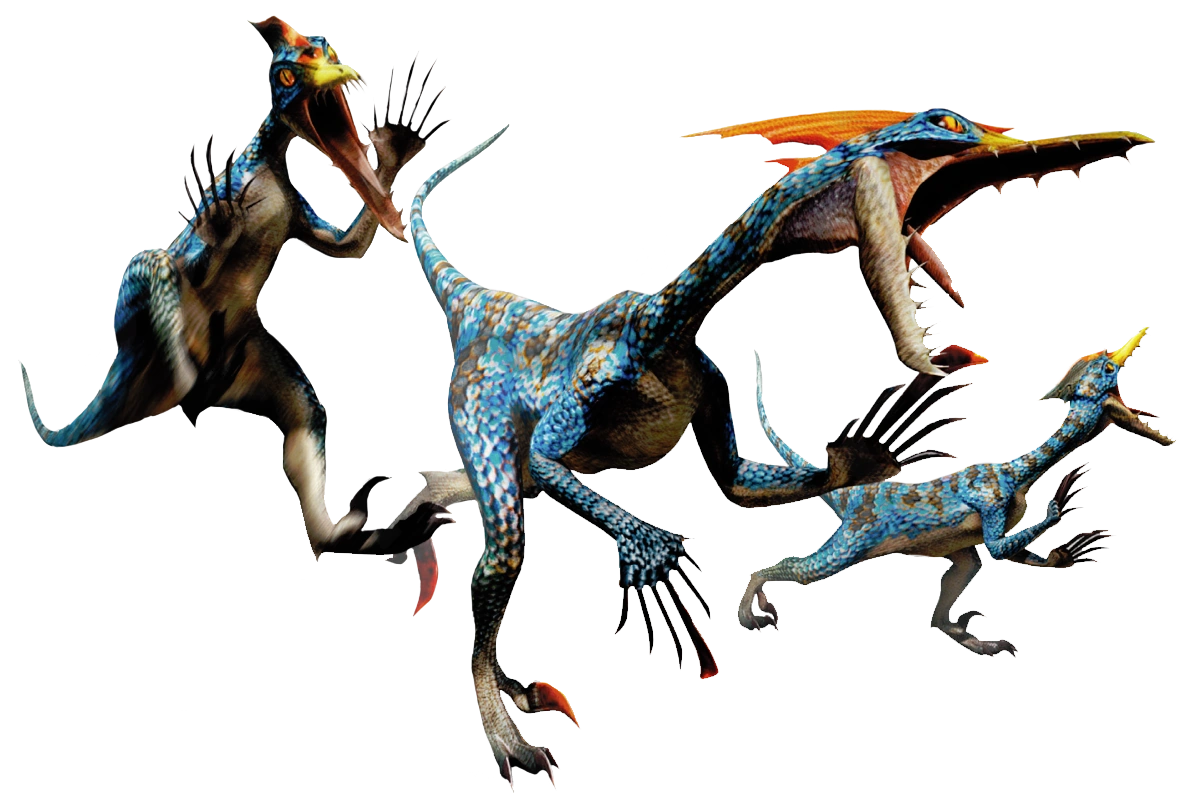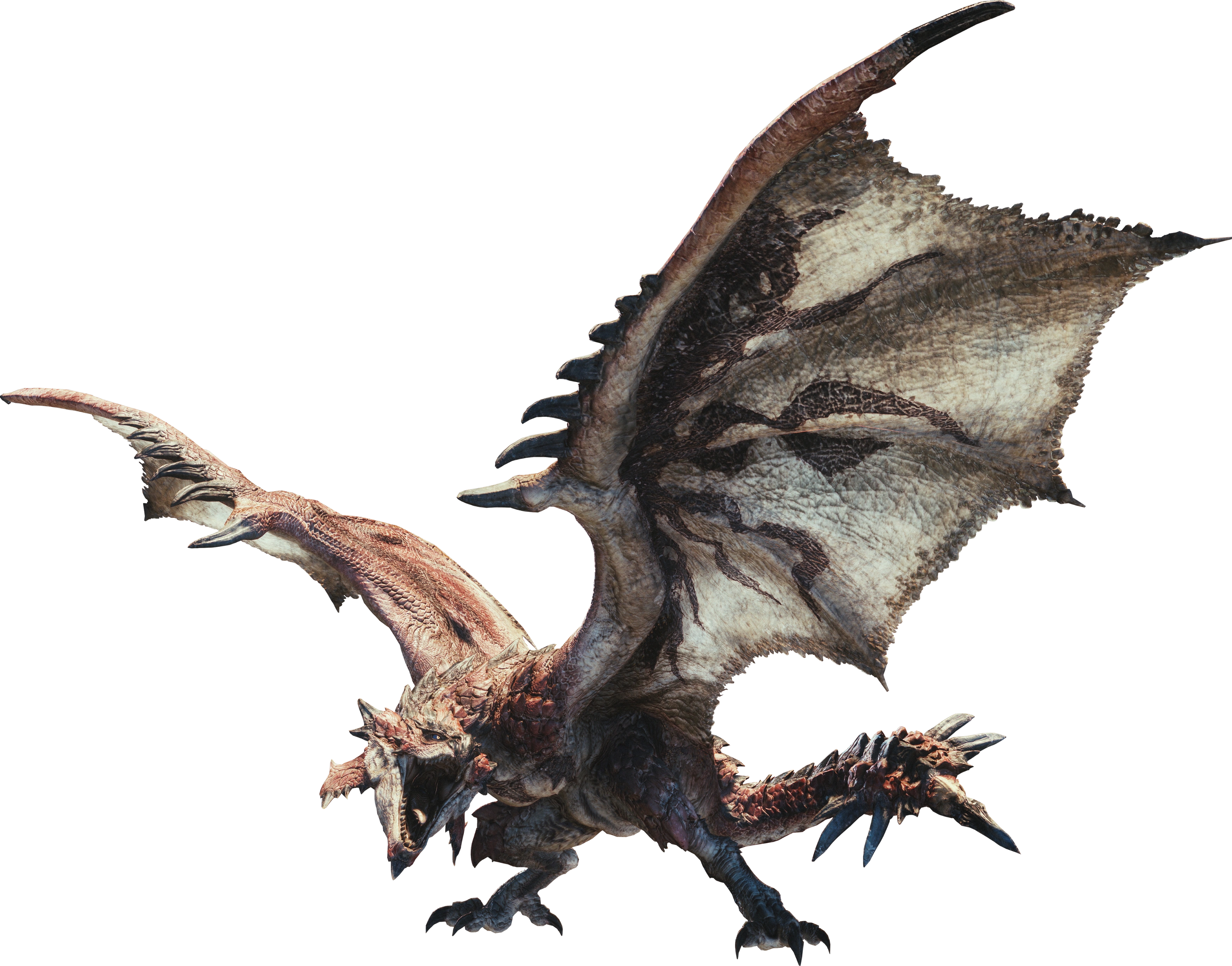 Rathalos and Rathian are male and female fire-breathing Flying Wyverns. The Fire Wyverns are covered in ridged and segmented shells on much of their body, and the rest is covered by scales to prevent impeding movement. However, their wing membranes are scaleless. Their clawed feet each have three toes facing forward and one pointing back, which allows them to grasp prey.
Rathalos and Rathian are male and female fire-breathing Flying Wyverns. The Fire Wyverns are covered in ridged and segmented shells on much of their body, and the rest is covered by scales to prevent impeding movement. However, their wing membranes are scaleless. Their clawed feet each have three toes facing forward and one pointing back, which allows them to grasp prey.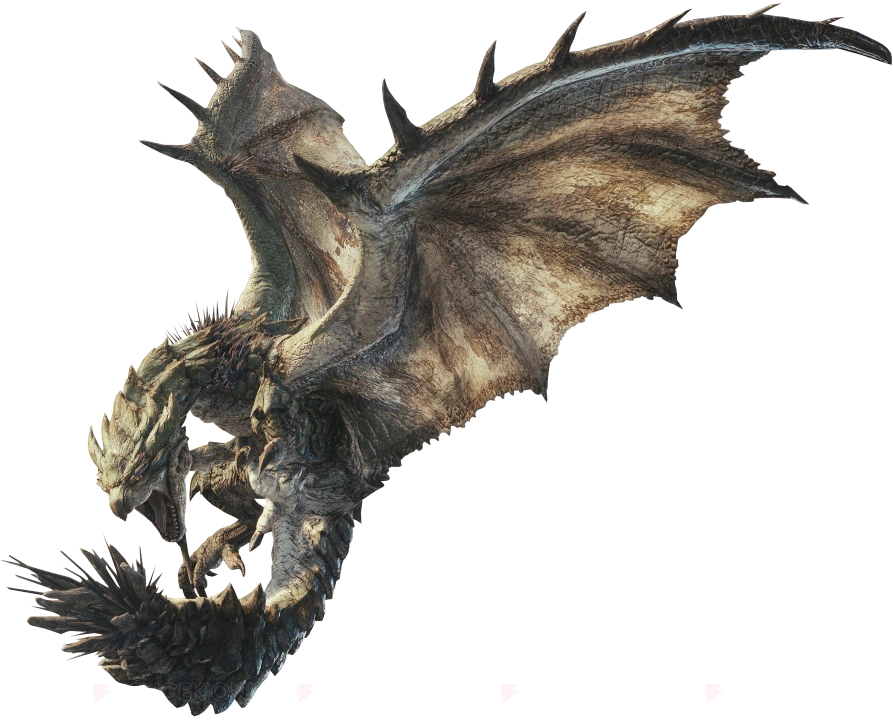 Rathalos and Rathian are known by different names dues to their very pronounced sexual dimorphism, varying in both physiology and behavior. Rathalos prefer to stay in the air and hold the title of "King of the Skies", while Rathian tend to remain on land and are known as the "Queen of the Land". To camouflage themselves better on the ground, Rathian have drab greenish-brown shells and scales. In stark contrast, Rathalos have a bright red coloration.
Rathalos and Rathian are known by different names dues to their very pronounced sexual dimorphism, varying in both physiology and behavior. Rathalos prefer to stay in the air and hold the title of "King of the Skies", while Rathian tend to remain on land and are known as the "Queen of the Land". To camouflage themselves better on the ground, Rathian have drab greenish-brown shells and scales. In stark contrast, Rathalos have a bright red coloration.Additionally, Rathalos have a few black stripes running along the length of their body and their legs. Black stripes also radiate from the wrist joint of their wing across their wing membranes, forming a flame pattern. [When contrasted with their pale undersides, it is likely that they display an intimidation signal to other large monsters in flight.] In comparison, Rathian wings only have a mottled pattern.
The spikes on a Rathian's wings are larger and more prominent as well, probably to deter attacks from other ground-dwelling monsters on the relatively fragile wings. Rathalos have smaller spikes on their wings making them more aerodynamic. A Rathalos's powerful wings allow them to carry their prey to a secure location if necessary, avoiding fights with other large predators. In turf wars with other monsters, they have been observed to lift up opponents of the same size and toss them around like ragdolls. Small scales between the shell pieces near their shoulder allow them to move their wings without being hindered. The soft skin under these scales also expands and contracts as they flap their wings, allowing free movement of the wings and so they can even fly through narrow spaces.
Other than that, a Rathalos's exoskeletal shells appears to be rougher and has more ornate patterns than the Rathian's smoother shells. This is also observed in the short backwards-protruding crown of spines on their heads. On a Rathalos, these appear to be shorter, thicker and more textured than the Rathian's slender and smoother ones. Besides that, Rathian has a longer forward-pointing spike on her chin which she uses to feed her young. This feature is less-developed in Rathalos, though they instead have larger spines protruding from both sides of the base of their lower jaw. During the breeding season, these spines enlarge and Rathalos use them to construct nests before mating with Rathian.
Rathalos and Rathian are well known for using fire as a weapon. They are able to achieve this by possessing flame sacs containing a pyrophoric powder. *When breathing fire, they actually burn themselves but their throats are adapted to heal and recover quickly from the injury.* Rathian have more powerful flame sacs than Rathalos, being able to expel a large explosive fireball that covers a larger area in fire. Despite being able to produce up to three fireballs in quick succession while on land, they do not breathe fire while they are airborne. The opposite condition is found in Rathalos, which breathe fire on land more sparingly, but can unleash multiple fireballs once they take to the air. Furthermore, Rathalos are able to expel short bursts of flame, which they may even use while biting targets to increase damage, [slightly compensating for being less adept at land-based combat otherwise.] When low on stamina, they become unable to use their fire sacs effectively. On the other hand, their mouths will constantly burn with fire when enraged.
Besides fire, Rathalos and Rathian are capable of attacking prey with poison. While Rathalos have venomous claws on their feet, Rathians have venom-secreting thorns on the ends of their tail. As a result, Rathalos and Rathian have distinct clubbed tails. Rathian tails have a rosette of backward-facing spikes along with the cluster of thorns, while Rathalos have three pairs of side-facing thagomizer spikes and a single backwards-facing spike at the tip of its tail. Even from a grounded position, Rathian can rapidly whip their tails in front of themselves to envenomate targets by performing a backflip. The toxic thorns are also found on Rathian's shoulders and on the wrist joints of its wings for defense on the ground.
The ranges of the Fire Wyverns overlap in many tropical and temperate areas, from forests to mountainous areas. [Unlike Rathian, Rathalos are not encountered in the densest jungles as the thick vegetation impedes their flight.] Rathian and Rathalos are found separately in deserts and volcanoes too, [which are unable to support a pair of Fire Wyverns living together.] The scarlet coloration of Rathalos allows them to camouflage in volcanic areas, [while Rathian is able to blend in with desert and savanna terrain.] The Fire Wyverns mark their territory with gashes on trees or on the ground.
Rathalos and Rathian are powerful predators that prey on anything they can take down, though they prefer to hunt the weaker Herbivores and Gargwa. Their mouths are lined with a row of sharp teeth and their snout ends in a hooked tip, evidently used to slice and tear flesh. Naturally, they have extremely good eyesight, which is especially important for Rathalos. Typically, Rathalos swoop at their prey from the air, and Rathian also use this technique when hunting larger prey such as Aptonoth. Alternatively, Rathian can hunt smaller prey such as Kelbi and small Bird Wyverns by chasing them down and snatching them up in their jaws. When hunting, they may use their roars to stun prey as well. Rathalos eats about three to four times a day and hunts in different places daily, depending on the weather and location/path of an Aptonoth herd.
Besides fire, Rathalos and Rathian are capable of attacking prey with poison. While Rathalos have venomous claws on their feet, Rathians have venom-secreting thorns on the ends of their tail. As a result, Rathalos and Rathian have distinct clubbed tails. Rathian tails have a rosette of backward-facing spikes along with the cluster of thorns, while Rathalos have three pairs of side-facing thagomizer spikes and a single backwards-facing spike at the tip of its tail. Even from a grounded position, Rathian can rapidly whip their tails in front of themselves to envenomate targets by performing a backflip. The toxic thorns are also found on Rathian's shoulders and on the wrist joints of its wings for defense on the ground.
The ranges of the Fire Wyverns overlap in many tropical and temperate areas, from forests to mountainous areas. [Unlike Rathian, Rathalos are not encountered in the densest jungles as the thick vegetation impedes their flight.] Rathian and Rathalos are found separately in deserts and volcanoes too, [which are unable to support a pair of Fire Wyverns living together.] The scarlet coloration of Rathalos allows them to camouflage in volcanic areas, [while Rathian is able to blend in with desert and savanna terrain.] The Fire Wyverns mark their territory with gashes on trees or on the ground.
In the New World, Rathalos and Rathian have improved flight capabilities compared to their Old World counterparts. Their wings have an an extra bone in their wings forming an extra "wing finger" supporting the wing membrane, making their wings more flexible for flying through the dense Ancient Forest and larger to avoid the more numerous threats in the New World. New World Rathalos also have greatly thickened thigh muscles to allow them to take off without much effort. The ancestors of these New World Raths were already particularly great flyers that came from the Old World. Additionally, New World Rathians have more thorns on their bodies.
Unlike most Flying Wyverns, the Fire Wyverns raise their young cooperatively. However, optimal nesting grounds are limited and Rathalos compete with one another for the best locations. In turn, Rathian also fight with each other to pair up with a Rathalos, as a Rathalos will mate multiple Rathian entering his territory but will only allow the strongest to remain as a nesting partner. Such fights between Rathian have even reportedly resulted in a forest fire in one case. Rathian that lose these battles tend to end up in poorer habitats such as deserts and are forced to rear their whelps alone. These unsuccessful Rathian are more vigilant and aggressive as a result. Despite that, their whelps have a relatively well-developed digestive system and dentition, allowing their mothers to feed them meat. They have a clutch size of about 10 eggs. Nesting Rathian do not normally stray far from their nest, picking off small monsters which they can easily carry back to their young. Occasionally, Rathian will allow smaller monsters to enter her territory to feed on smaller creatures that pose a threat to her nest. In the Wildspire Waste, Rathian have even been observed intelligently igniting oil puddles to scare away threats. While Rathian are primarily responsible for keeping their young warm and feeding them, Rathalos spend less time near the nest. A Rathalos is in charge of hunting and carrying large prey back to the nest while patrolling his territory for intruders which may threaten his family. If a paired Rathian or Rathalos ever encounters an enemy stronger than they can face alone, they will call for their mate to assist them. Beyond Elder Dragons and "Elder-Dragon Level" monsters, there are virtually no monsters capable of standing up against a pair of Fire Wyverns.
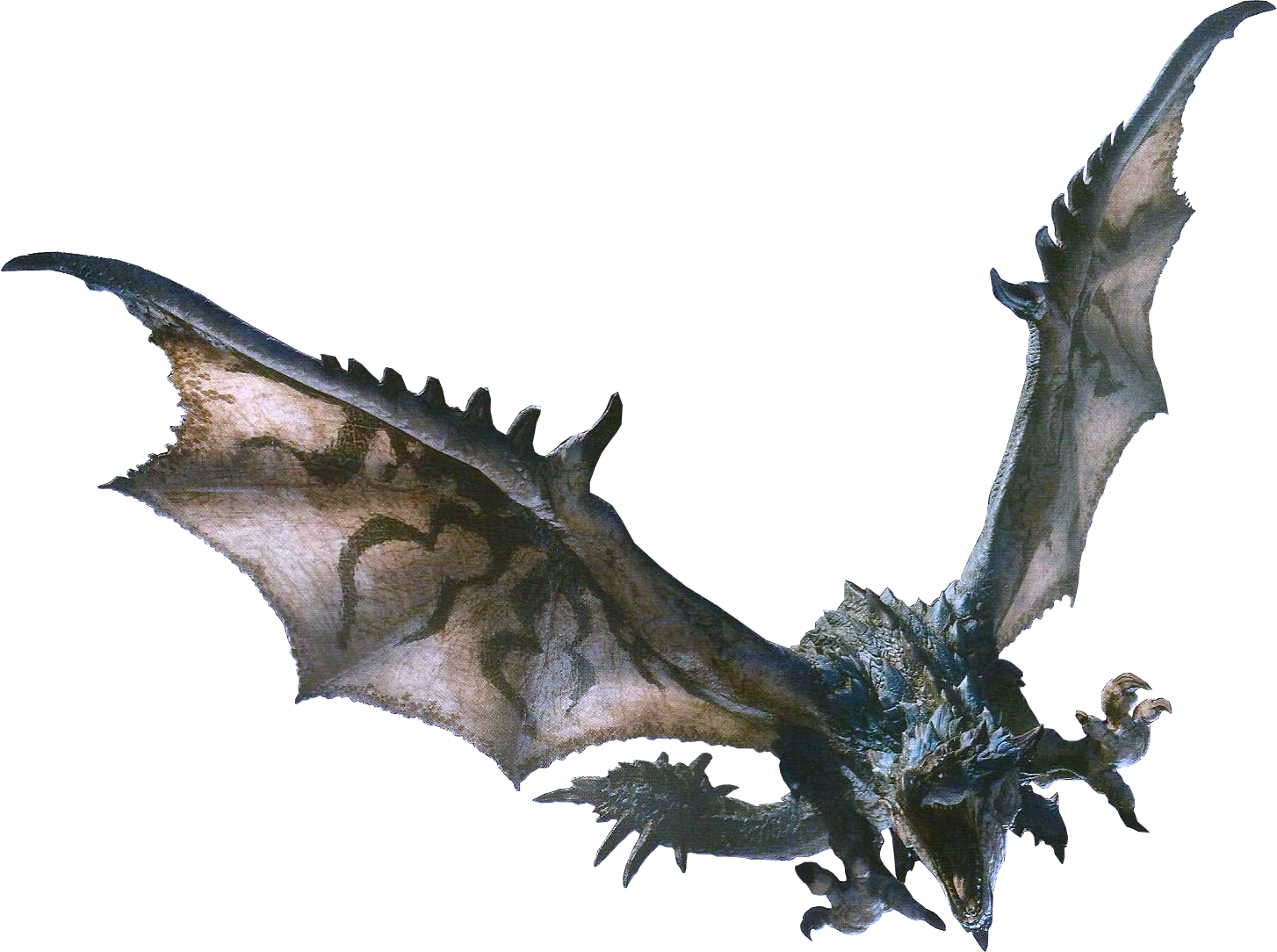
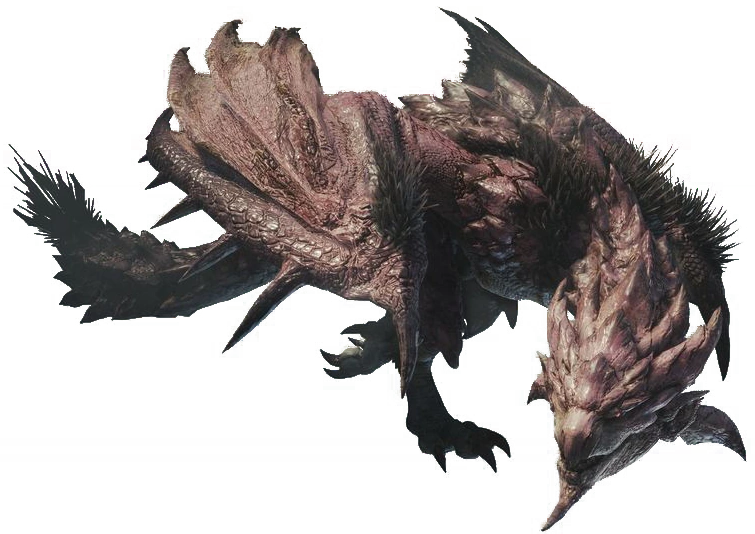 Azure Rathalos and Pink Rathian are extremely rarely encountered Subspecies of Rathalos and Rathian that have matured in areas with high bioenergy, such as the Elder's Recess. The bioenergy causes them to change color and develop differently, causing their shells to become harder and their scales and skin to become more flexible. Azure Rathalos have slightly different elemental resistances as well. Despite that, their garish coloration also decreases their likelihood of survival, so they have become more aggressive and proficient in their attacks. Azure Rathalos tend to spend more time airborne and chain aerial attacks together, but this depletes their stamina faster than normal Rathalos. Likewise, Pink Rathian are more skilled in wielding their tails in combination with complex backflip maneuvers and may possess more potent venom. *Although both Subspecies are capable of staying in the same habitats as their normal counterparts, they prefer highland and forested regions. These regions allow Azure Rathalos to blend in slightly better, and Pink Rathian follow them* since both of their normal counterparts do not recognize their Subspecies as potential mates. In fact, normal and Subspecies counterparts are very hostile towards each other, engaging in turf wars often. It is worth noting that the coloration of Pink Rathians allows them to blend in extremely well in the Coral Highlands, though large prey items are scarcer there.
Azure Rathalos and Pink Rathian are extremely rarely encountered Subspecies of Rathalos and Rathian that have matured in areas with high bioenergy, such as the Elder's Recess. The bioenergy causes them to change color and develop differently, causing their shells to become harder and their scales and skin to become more flexible. Azure Rathalos have slightly different elemental resistances as well. Despite that, their garish coloration also decreases their likelihood of survival, so they have become more aggressive and proficient in their attacks. Azure Rathalos tend to spend more time airborne and chain aerial attacks together, but this depletes their stamina faster than normal Rathalos. Likewise, Pink Rathian are more skilled in wielding their tails in combination with complex backflip maneuvers and may possess more potent venom. *Although both Subspecies are capable of staying in the same habitats as their normal counterparts, they prefer highland and forested regions. These regions allow Azure Rathalos to blend in slightly better, and Pink Rathian follow them* since both of their normal counterparts do not recognize their Subspecies as potential mates. In fact, normal and Subspecies counterparts are very hostile towards each other, engaging in turf wars often. It is worth noting that the coloration of Pink Rathians allows them to blend in extremely well in the Coral Highlands, though large prey items are scarcer there.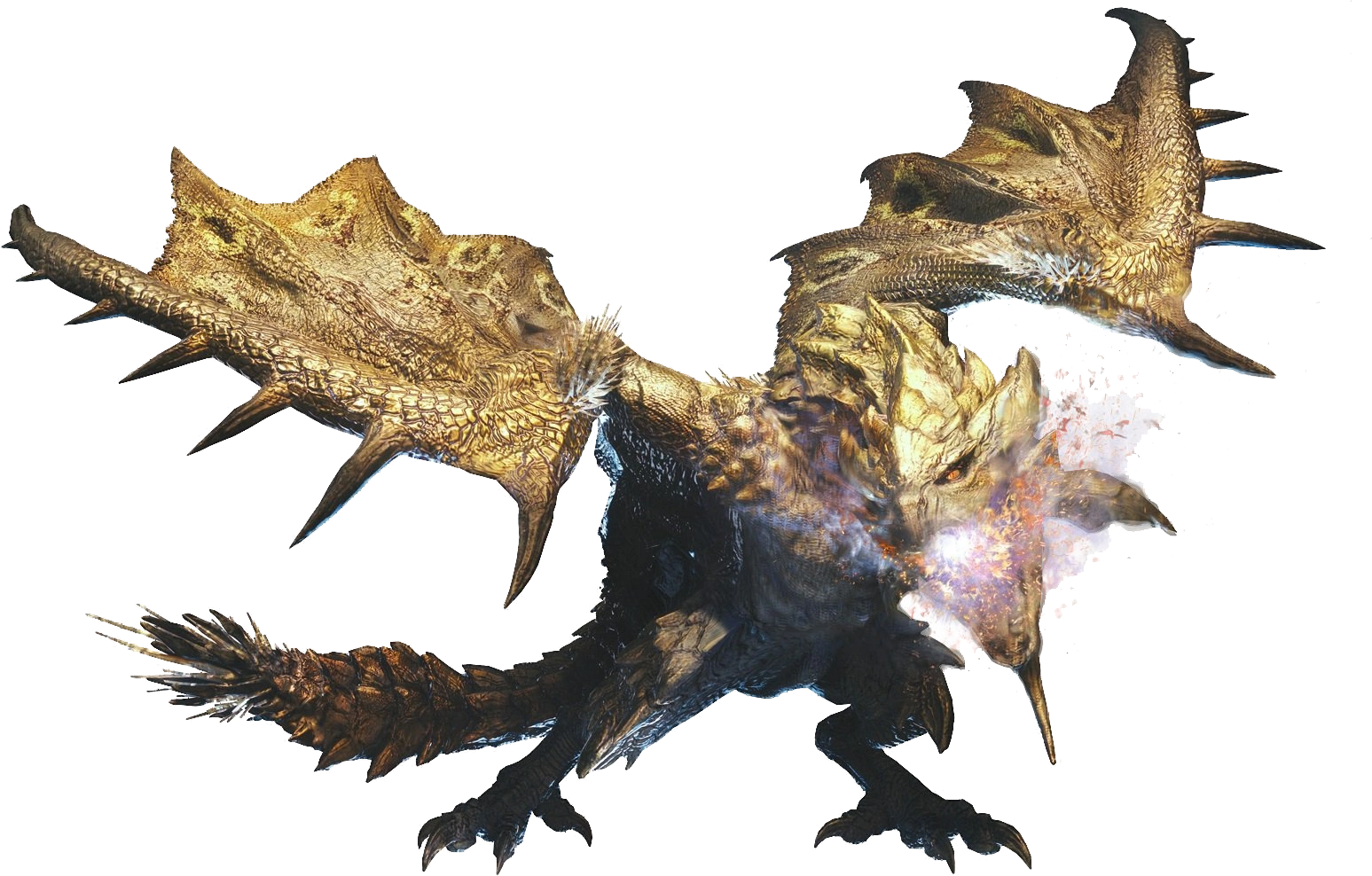 The Rare Species are known as Silver Rathalos and Gold Rathian. How these Rare Species arise is still uncertain, though they may emerge under similar conditions as those responsible for their Subspecies counterparts. They are extremely rare, even more so than their Subspecies counterparts and possess strength close to that of Elder Dragons. Silver Rathalos are even more adept in the air, while Gold Rathian wield their tails even more deftly. The venom in their toxic needles are just as noxious or are even more noxious than Pink Rathian's poison. Both Rare Species have tremendously augmented firepower, able to spew highly explosive fireballs. In the New World, they are even able to enter a "Hellfire State" distinct from their enraged state, where their inferno sacs glow brightly along with some parts of their upper body. In this state, their already impressive firepower is further increased, allowing them to expel blue flames that burn hotter than normal fire.
The Rare Species are known as Silver Rathalos and Gold Rathian. How these Rare Species arise is still uncertain, though they may emerge under similar conditions as those responsible for their Subspecies counterparts. They are extremely rare, even more so than their Subspecies counterparts and possess strength close to that of Elder Dragons. Silver Rathalos are even more adept in the air, while Gold Rathian wield their tails even more deftly. The venom in their toxic needles are just as noxious or are even more noxious than Pink Rathian's poison. Both Rare Species have tremendously augmented firepower, able to spew highly explosive fireballs. In the New World, they are even able to enter a "Hellfire State" distinct from their enraged state, where their inferno sacs glow brightly along with some parts of their upper body. In this state, their already impressive firepower is further increased, allowing them to expel blue flames that burn hotter than normal fire.The source of their lustrous sheen is unknown, though it may be metallic in origin, seeing as how their resistance to the Thunder element has decreased. That being said, their exoskeletal shells are the toughest of any Fire Wyvern. Their weakspots are now mainly located on their wings and legs, which are not as well-armored. Due to the composition of their exoskeleton, they are not found in areas with high temperatures such as deserts and volcanoes, unlike their normal counterparts and Subspecies, because their shells absorb heat too quickly. In the Old World, they primarily nest in or near the mysterious Tower but will also hunt in other temperate and tropical areas. [It's possible that they are normally encountered near the Tower due to the bioenergy content of the Elder Dragon materials used to build some parts of the Tower.] In the New World, they are only encountered in the Guiding Lands and Elder's Recess, which are teeming with bioenergy.
